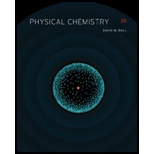
Physical Chemistry
2nd Edition
ISBN: 9781133958437
Author: Ball, David W. (david Warren), BAER, Tomas
Publisher: Wadsworth Cengage Learning,
expand_more
expand_more
format_list_bulleted
Question
Chapter 18, Problem 18.42E
Interpretation Introduction
Interpretation:
Of the heat capacities
Concept introduction:
The
The
Expert Solution & Answer
Want to see the full answer?
Check out a sample textbook solution
Students have asked these similar questions
How does the square root mean square velocity of gas molecules vary with temperature? Illustrate this relationship by plotting the square root mean square velocity of N2 molecules as a function of temperature from T=100 K to T=300 K.
Draw product B, indicating what type of reaction occurs.
F3C
CF3
NH2
Me O
.N.
+
B
OMe
Benzimidazole E. State its formula. sState the differences in the formula with other benzimidazoles.
Chapter 18 Solutions
Physical Chemistry
Ch. 18 - Prob. 18.1ECh. 18 - Prob. 18.2ECh. 18 - Prob. 18.3ECh. 18 - Prob. 18.4ECh. 18 - The following are the first four electronic energy...Ch. 18 - Prob. 18.6ECh. 18 - Prob. 18.7ECh. 18 - Prob. 18.8ECh. 18 - Prob. 18.9ECh. 18 - Prob. 18.10E
Ch. 18 - Prob. 18.11ECh. 18 - Prob. 18.12ECh. 18 - Prob. 18.13ECh. 18 - Prob. 18.14ECh. 18 - Prob. 18.15ECh. 18 - Prob. 18.16ECh. 18 - Prob. 18.17ECh. 18 - Prob. 18.18ECh. 18 - Prob. 18.19ECh. 18 - Prob. 18.20ECh. 18 - Prob. 18.21ECh. 18 - Prob. 18.22ECh. 18 - Prob. 18.23ECh. 18 - Prob. 18.24ECh. 18 - Prob. 18.25ECh. 18 - Prob. 18.26ECh. 18 - Prob. 18.27ECh. 18 - Prob. 18.28ECh. 18 - Prob. 18.29ECh. 18 - Prob. 18.30ECh. 18 - Prob. 18.31ECh. 18 - Prob. 18.32ECh. 18 - Prob. 18.33ECh. 18 - What are qnuc and qrot for N2(I=1)? See Table 18.3...Ch. 18 - The rovibrational spectrum of acetylene, HCCH,...Ch. 18 - Prob. 18.36ECh. 18 - Prob. 18.37ECh. 18 - Prob. 18.38ECh. 18 - Prob. 18.39ECh. 18 - Prob. 18.40ECh. 18 - Prob. 18.41ECh. 18 - Prob. 18.42ECh. 18 - Use equation 18.44 to show that pV=NkT.Ch. 18 - Prob. 18.44ECh. 18 - Determine E,H,G, and S for CH4 at standard...Ch. 18 - Prob. 18.48ECh. 18 - Prob. 18.49ECh. 18 - Calculate the heat capacity of NO2 at 298K and...Ch. 18 - Prob. 18.51ECh. 18 - In Chapters 17 and 18 we have derived expressions...Ch. 18 - Prob. 18.55ECh. 18 - Prob. 18.56ECh. 18 - Prob. 18.57ECh. 18 - Prob. 18.58ECh. 18 - Prob. 18.59ECh. 18 - Prob. 18.60E
Knowledge Booster
Similar questions
- Draw product A, indicating what type of reaction occurs. F3C CN CF3 K2CO3, DMSO, H₂O2 Aarrow_forward19) Which metal is most commonly used in galvanization to protect steel structures from oxidation? Lead a. b. Tin C. Nickel d. Zinc 20) The following molecule is an example of a: R₁ R2- -N-R3 a. Secondary amine b. Secondary amide c. Tertiary amine d. Tertiary amidearrow_forwardpls helparrow_forward
- pls helparrow_forward35) Complete the following equation by drawing the line the structure of the products that are formed. Please note that in some cases more than one product is possible. You must draw all possible products to recive full marks! a. ethanol + 2-propanol + H2SO4 → b. OH conc. H2SO4 CH2 H3C CH + K2Cr2O7 C. d. H3C A pressure CH3 + H2 CH Pt catalystarrow_forward21) The rate of reaction depends upon: a. the concentration and nature of reactants b. the temperature of the reaction C. whether or not a catalyst was used d. all of the above 22) A Maxwell-Boltzmann curve shows the distribution of molecular energies in a reaction system. When the temperature in this system is increased, the peak is a. higher and further to the right. b. higher and further to the left. c. lower and further to the right. d. lower and further to the left. 23) Which of the following correctly describes the reaction represented by the reaction below? CaCO3 (s) + energy → CaO (s) + CO2 (g) a. It is exothermic and the potential energy is greater in the reactants than the products. b. c. It is exothermic and the potential energy is greater in the products than the reactants. It is endothermic and the potential energy is greater in the products than the reactants. d. It is endothermic and the potential energy is equal for the products and reactants.arrow_forward
arrow_back_ios
SEE MORE QUESTIONS
arrow_forward_ios
Recommended textbooks for you
 Physical ChemistryChemistryISBN:9781133958437Author:Ball, David W. (david Warren), BAER, TomasPublisher:Wadsworth Cengage Learning,
Physical ChemistryChemistryISBN:9781133958437Author:Ball, David W. (david Warren), BAER, TomasPublisher:Wadsworth Cengage Learning, Principles of Modern ChemistryChemistryISBN:9781305079113Author:David W. Oxtoby, H. Pat Gillis, Laurie J. ButlerPublisher:Cengage Learning
Principles of Modern ChemistryChemistryISBN:9781305079113Author:David W. Oxtoby, H. Pat Gillis, Laurie J. ButlerPublisher:Cengage Learning Chemistry: Principles and PracticeChemistryISBN:9780534420123Author:Daniel L. Reger, Scott R. Goode, David W. Ball, Edward MercerPublisher:Cengage Learning
Chemistry: Principles and PracticeChemistryISBN:9780534420123Author:Daniel L. Reger, Scott R. Goode, David W. Ball, Edward MercerPublisher:Cengage Learning Chemistry for Engineering StudentsChemistryISBN:9781337398909Author:Lawrence S. Brown, Tom HolmePublisher:Cengage Learning
Chemistry for Engineering StudentsChemistryISBN:9781337398909Author:Lawrence S. Brown, Tom HolmePublisher:Cengage Learning Introductory Chemistry: A FoundationChemistryISBN:9781337399425Author:Steven S. Zumdahl, Donald J. DeCostePublisher:Cengage Learning
Introductory Chemistry: A FoundationChemistryISBN:9781337399425Author:Steven S. Zumdahl, Donald J. DeCostePublisher:Cengage Learning Chemistry: The Molecular ScienceChemistryISBN:9781285199047Author:John W. Moore, Conrad L. StanitskiPublisher:Cengage Learning
Chemistry: The Molecular ScienceChemistryISBN:9781285199047Author:John W. Moore, Conrad L. StanitskiPublisher:Cengage Learning

Physical Chemistry
Chemistry
ISBN:9781133958437
Author:Ball, David W. (david Warren), BAER, Tomas
Publisher:Wadsworth Cengage Learning,

Principles of Modern Chemistry
Chemistry
ISBN:9781305079113
Author:David W. Oxtoby, H. Pat Gillis, Laurie J. Butler
Publisher:Cengage Learning

Chemistry: Principles and Practice
Chemistry
ISBN:9780534420123
Author:Daniel L. Reger, Scott R. Goode, David W. Ball, Edward Mercer
Publisher:Cengage Learning

Chemistry for Engineering Students
Chemistry
ISBN:9781337398909
Author:Lawrence S. Brown, Tom Holme
Publisher:Cengage Learning

Introductory Chemistry: A Foundation
Chemistry
ISBN:9781337399425
Author:Steven S. Zumdahl, Donald J. DeCoste
Publisher:Cengage Learning

Chemistry: The Molecular Science
Chemistry
ISBN:9781285199047
Author:John W. Moore, Conrad L. Stanitski
Publisher:Cengage Learning